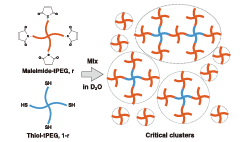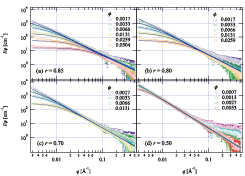Structure of Critical Gel Clusters Formed by Tetra-Functional Polymers
Shibayama Group
Critical gel clusters are polymer clusters about to become a gel. With a bit more reaction, the critical clusters percolate the system and system changes from fluid “sol” to solid “gel”. Polymer gels can be synthesized by various chemical methods: radical polymerization of monomers and crosslinkers, crosslinking the side groups of linear polymer chains by cross-linkers or by irradiation of γ-rays, coupling end-groups of star polymers, etc. Although there are many different reaction schemes to synthesize gels and different network structure are formed depending on the synthesis schemes, a set of universal scaling laws are commonly observed near the gel point, including size-distribution, weight-averaged molecular weight, correlation length.

Fig. 1. Schematic for preparation of critical clusters from two different tetra-PEG units carrying mutual reactive end-groups. The excess red polymers cover the surface of the clusters and the reaction automatically stops. With one addition blue units, the clusters will percolate the system. Reprinted with permission from SANS Study on Critical Polymer Clusters of Tetra-Functional Polymers, Xiang Li, Kazu Hirosawa, Takamasa Sakai, Elliot P. Gilbert, and Mitsuhiro Shibayama, Macromolecules 2017 50 (9), 3655-3661. Copyright 2018 American Chemical Society.

Fig. 2. Scattering profiles of various critical clusters based on the 2D sol-gel phase diagram (a, r=0.85; b, r=0.80; c, r=0.70; d, r=0.5). The profiles of the dilution of each clusters-solution are also shown. The blue curves show the fitting curves of the Bastide-Candau model for scattering profiles of critical clusters solution with finite polymer concentration. Reprinted with permission from SANS Study on Critical Polymer Clusters of Tetra-Functional Polymers, Xiang Li, Kazu Hirosawa, Takamasa Sakai, Elliot P. Gilbert, and Mitsuhiro Shibayama, Macromolecules 2017 50 (9), 3655-3661. Copyright 2018 American Chemical Society.
Although those scaling laws of critical clusters have already been well studied, most of the studies only focused on reaction-conversion-limited clusters (1D phase diagram). The sol-gel phase diagram indeed has three variables: the polymer (or monomer) concentration (φ), the crosslinker density and the reaction conversion. The lack of studies based on the multi-dimension phase diagram is due to poor reproducibility in forming critical clusters, and difficulty in controlling the polymer concentration and crosslinker density.
Recently, we have successfully synthesized a new type of critical clusters by mixing two different types of tetra-armed poly(ethylene glycol) polymers (tetra-PEGs) with mutual reactive end-groups by offstoichiometric molar ratios (r, r = 0.5 denotes equal stoichiometric ratio) (Fig. 1). By changing the polymer concentration and the molar ratio of two tetra-PEGs (= crosslinker density), we can easily draw a 2D-phase diagram of the critical clusters. Here, we report the structure of these critical clusters studied by means of small angle neutron scattering (SANS) [1-2].
Figure 2 shows the normalized scattering intensity (I/φ) for different critical clusters formed based on the 2D-phase diagram. The normalized scattering intensity (I/φ) converged at the q-range of the size of prepolymers (q > 0.1Å-1) because all the polymer clusters are formed with the same prepolymers. The slight upper deviation of low concentration sample are due to the low couniting statistics of scattered neutrons. In the q-range of the size larger than a prepolymer (q < 0.1Å-1), the SANS profiles are well reproduced by the Bastide-Candau model, which is designed for the scattering of critical gel clusters at finite concentration regime. The fractal dimension (Ds) of swollen critical clusters and the size-distribution exponent (Fisher exponent, τ) were estimated from the fitting parameters. Ds was a unique value (= 2.0 ± 0.1) irrespective of preparation condition while the values of τ increased from 1.90 to 2.25 with deviating r from the stoichiometric ratio (r = 0.5), suggesting that smaller polymer clusters tend to be formed in off-stoichiometric ratio. This study clearly shows that the fractal structure of the critical clusters is universal irrespective of the synthesized condition, while the size-distribution of critical clusters is a tunable parameter, which was unexpected by the classical percolation theory.
References
- [1] X. Li, K. Hirosawa, T. Sakai, E. P. Gilbert, and M. Shibayama, Macromolecules 50, 3655 (2017).
- [2] K. Hayashi, F. Okamoto, S. Hoshi, T. Katashima, D. C. Zujur, X. Li, M. Shibayama, E. P. Gilbert, U.-I. Chung, S. Ohba et al., Nat. Biomed. Eng. 1, 0044 (2017).
